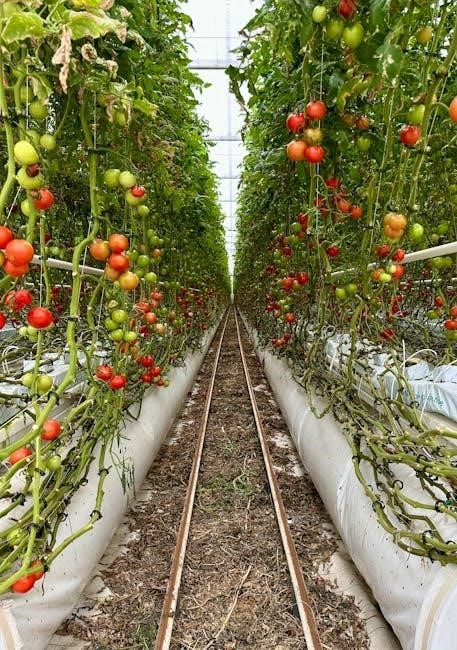The SCD Food List is a comprehensive guide for managing digestive health through diet․ It outlines allowed and prohibited foods, aiding users in making informed choices daily․
1․1 What is the SCD Diet?
The Specific Carbohydrate Diet (SCD) is a dietary approach designed to manage digestive disorders by restricting certain carbohydrates․ Developed by Dr․ Sidney Valentine Haas, it focuses on eliminating harmful sugars and promoting gut healing․ The diet emphasizes natural, easily digestible foods, aiming to restore intestinal health and reduce symptoms of conditions like celiac disease and inflammatory bowel disease․ It is based on the principle that undigested carbohydrates can exacerbate digestive issues․
1․2 Importance of the SCD Food List
The SCD Food List is crucial for guiding individuals on the Specific Carbohydrate Diet․ It provides clear distinctions between allowed and prohibited foods, helping users avoid harmful carbohydrates․ This list ensures adherence to the diet’s principles, promoting gut healing and symptom relief․ By following it, individuals can maintain dietary compliance, reduce digestive discomfort, and achieve long-term health benefits․ It serves as an essential tool for effective meal planning and grocery shopping, enhancing overall well-being․
1․3 Purpose of the SCD Food List PDF
The SCD Food List PDF serves as a portable and accessible reference guide for individuals following the Specific Carbohydrate Diet․ Its purpose is to simplify the process of identifying safe and harmful foods, ensuring dietary compliance․ By categorizing foods clearly, it aids in meal planning and grocery shopping, helping users maintain consistency with the diet’s requirements․ This resource is designed to empower individuals to manage their health effectively and make informed dietary decisions on a daily basis․

Overview of the SCD Diet
The SCD Diet is a structured dietary approach focusing on eliminating harmful carbohydrates and promoting gut healing․ It emphasizes nutrient-dense foods to restore digestive health and overall well-being․
2․1 Definition and History of the SCD Diet
The Specific Carbohydrate Diet (SCD) is a dietary regimen that eliminates harmful carbohydrates, focusing on easily digestible foods․ Developed by Dr․ Sidney Valentine Haas in the 1920s, it aims to heal the gut by removing sugars and starches that can cause inflammation․ The diet gained popularity as a natural approach to managing conditions like celiac disease and inflammatory bowel disease, emphasizing legal and illegal food categories to promote intestinal healing and overall health․
2․2 Key Principles of the SCD Diet
The SCD Diet focuses on restricting carbohydrates that are difficult to digest, such as disaccharides, starches, and most sugars․ It emphasizes nutrient-dense foods like meats, fish, eggs, vegetables, and select fruits․ The diet eliminates grains, lactose, and processed foods to reduce inflammation and promote gut healing․ Foods are categorized as “legal” or “illegal” based on their digestibility, with a gradual introduction of new foods to assess tolerance and maintain digestive health․
2․3 Benefits of Following the SCD Diet
Following the SCD Diet can lead to significant health improvements, including reduced inflammation, improved digestion, and enhanced nutrient absorption․ Many individuals experience relief from symptoms like bloating, diarrhea, and abdominal pain․ The diet also supports gut healing, which may improve conditions like IBS, IBD, or SIBO․ By eliminating harmful foods and focusing on nutrient-dense options, users often report increased energy, clearer skin, and overall well-being․ Consistency with the diet can lead to long-term health benefits and improved quality of life․

Understanding the SCD Food List
The SCD Food List is a comprehensive guide detailing allowed and prohibited foods, helping users identify safe choices for their dietary needs․ It organizes foods into clear categories, such as meats, vegetables, and dairy, with specific serving sizes and preparation methods․ This resource simplifies meal planning and ensures compliance with the diet, making it easier to track progress and maintain health goals effectively․
3․1 Categories of Foods in the SCD List
The SCD Food List categorizes foods into clear groups, such as meats, vegetables, fruits, dairy, and fats․ Each category specifies allowed and prohibited items, ensuring dietary clarity․ For example, meats must be fresh and unprocessed, while vegetables are divided into safe and unsafe options based on digestibility․ This structured approach helps users easily identify suitable foods, promoting adherence to the diet and minimizing confusion during meal preparation and grocery shopping․
3․2 How the Food List is Organized
The SCD Food List is organized into logical sections, making it easy to navigate․ Foods are grouped by category, such as meats, vegetables, and dairy, with clear labels indicating allowed, prohibited, or conditional items․ Visual cues like colors or symbols may highlight restrictions, ensuring quick identification․ This structured format reduces confusion and helps users make informed decisions, aligning with the diet’s principles for optimal digestion and health benefits․
3․3 Importance of Adhering to the List
Adhering to the SCD Food List is crucial for achieving digestive healing and managing symptoms․ It ensures the removal of harmful substances and promotes nutrient absorption․ By following the list, individuals avoid foods that trigger inflammation and setbacks․ Compliance helps tailor the diet to specific health needs, supporting long-term gut health and overall well-being․ Strict adherence maximizes the diet’s effectiveness and leads to better health outcomes for those with conditions like IBD or autism․

Allowed Foods on the SCD Diet
The SCD Diet emphasizes nutrient-dense foods like meats, poultry, fish, eggs, vegetables, and certain fruits․ Fermented foods and-specific dairy products are also permitted, aiding digestion and healing․
4․1 Permitted Foods and Their Benefits
The SCD Diet permits fresh, nutrient-dense foods like vegetables, fruits, meats, poultry, and fish․ These foods provide essential vitamins, minerals, and proteins․ Certain dairy products, such as yogurt and cheese, are allowed if lactose-free or fermented․ These foods support digestion, reduce inflammation, and promote healing․ The diet also includes healthy fats like avocado and olive oil, which aid in nutrient absorption and overall well-being․ These permitted foods are chosen for their ability to maintain gut health and prevent harmful bacterial overgrowth․
4․2 Gray-Area Foods Explained
Gray-area foods on the SCD Diet are those that may be tolerated by some but not others․ Examples include certain legumes, starchy vegetables, and low-lactose dairy products․ These foods are not strictly prohibited but should be introduced cautiously, typically after initial healing․ Their inclusion depends on individual tolerance and the stage of gut health․ Always test these foods slowly and monitor for any adverse reactions to ensure they align with your dietary goals․
4․3 Phase-Specific Foods in the SCD Diet
The SCD Diet introduces foods in phases to support gut healing․ Early phases focus on easily digestible foods like eggs, vegetables, and ripe fruits․ Later phases gradually add meats, nuts, and low-sugar fruits․ Each phase builds on the previous one, ensuring the gut can handle more complex foods․ This structured approach helps prevent overloading the digestive system and promotes long-term healing and nutrient absorption․ Strict adherence to phase guidelines is crucial for success․

Prohibited Foods on the SCD Diet
The SCD Diet prohibits grains, sugars, and processed foods to reduce inflammation and promote gut healing․ Avoiding these foods is essential for managing digestive disorders effectively․
5․1 Foods to Avoid and Why
The SCD Diet prohibits grains, starchy vegetables, high-sugar foods, processed items, and high-lactose dairy․ These foods contain complex carbohydrates that can feed harmful bacteria, leading to inflammation and gut damage․ Avoiding them helps restore gut health and reduce symptoms of digestive disorders․ The list ensures clarity on which foods are harmful and why their elimination is crucial for healing and maintaining dietary compliance․
5․2 Common Mistakes to Avoid
Common mistakes include accidental consumption of prohibited foods, such as hidden additives in processed items, and improper food preparation․ Some individuals rush through the introductory phases, leading to setbacks․ Others overlook the importance of reading labels or assume certain foods are safe without verification․ These errors can hinder progress and cause discomfort․ Consistency and vigilance are key to avoiding these pitfalls and achieving long-term success on the SCD Diet․
5․3 Hidden Sources of Prohibited Ingredients
Prohibited ingredients often hide in processed foods, sauces, condiments, and even seemingly harmless products like spices or flavored beverages․ Labeled as “natural” or “healthy,” some items may contain undisclosed additives․ Cross-contamination during processing or preparation can also introduce banned substances․ Always verify ingredient lists and be wary of alternative names for prohibited items to ensure compliance with the SCD Diet guidelines․

How to Use the SCD Food List PDF
Use the SCD Food List PDF as a reference to identify allowed and prohibited foods, check categories, and plan meals․ Track progress and stay compliant․
6․1 Step-by-Step Guide to the PDF
Access the SCD Food List PDF and familiarize yourself with its categories․ Start by reviewing the introduction to understand the diet’s basics․ Navigate through allowed and prohibited foods, noting any gray areas․ Use the list to plan meals, ensuring compliance with dietary restrictions․ Highlight or bookmark essential sections for quick reference․ Regularly update your copy to stay informed about any changes or additions to the food guidelines․
6․2 Tips for Meal Planning and Grocery Shopping
Plan meals weekly using the SCD Food List PDF to ensure compliance․ Create a grocery list highlighting allowed foods and avoid prohibited items; Shop the perimeter of the store for fresh produce, meats, and dairy․ Read labels carefully to identify hidden prohibited ingredients․ Stick to your list to minimize impulse purchases․ Prepping meals in advance can save time and reduce the risk of dietary slip-ups․ Stay organized to maintain long-term adherence to the SCD diet․
6․3 Tracking Progress with the Food List
Use the SCD Food List PDF to monitor your progress by tracking meals and symptoms․ Maintain a journal to note improvements or challenges․ Regularly review your food choices to ensure compliance and identify patterns․ Celebrate milestones, like reduced inflammation or improved digestion, to stay motivated․ Adjust your diet as needed based on how your body responds; Consistent tracking helps maintain accountability and guides long-term success on the SCD diet․

Creating a Custom SCD Food List
Customize your SCD Food List by personalizing it to suit your dietary needs, preferences, and health goals․ Start with the official SCD Food List PDF and tailor it by adding or removing foods based on your tolerance, preferences, and progress․ Consider your specific health conditions, allergies, and lifestyle to ensure the list aligns with your requirements․ You can categorize foods, note portion sizes, and include preparation tips․ This personalized approach helps in maintaining compliance and optimizing benefits․ Regularly update your list as your needs evolve and track your progress to refine it further․ Using tools like digital apps or spreadsheets can make the process efficient and accessible․ By creating a custom list, you can better manage your diet, avoid prohibited items, and focus on foods that promote healing and well-being․ This tailored resource becomes a valuable guide in your journey toward improved health on the SCD diet․
7․1 Personalizing the List for Individual Needs
Personalizing the SCD Food List involves tailoring it to your unique health conditions, allergies, and dietary preferences․ Start by identifying foods that trigger symptoms or allergies and remove them from your list․ Add notes or highlights to emphasize foods that work well for you․ Consider your lifestyle, such as busy schedules or cooking preferences, and adjust the list accordingly․ This customization ensures the diet remains practical and sustainable while addressing specific needs․ Regularly review and update your personalized list to reflect changes in tolerance or health goals, maximizing its effectiveness in supporting your healing journey․ By making the list your own, you enhance compliance and overall outcomes on the SCD diet․
7․2 Adding and Removing Foods Based on Progress
As you progress on the SCD diet, you may need to adjust your food list by adding or removing foods based on your body’s response․ Introduce new foods one at a time, monitoring for any adverse reactions․ If symptoms improve, keep the food; if not, remove it temporarily․ Regularly review and update your list to reflect changes in tolerance․ This adaptive approach ensures your diet remains effective and aligned with your healing journey․ Tracking progress helps refine your personalized plan for optimal results․
7․3 Tools for Creating a Custom PDF
Creating a custom SCD food list PDF can be simplified using tools like spreadsheet software (e․g․, Excel or Google Sheets) to organize foods․ PDF editors like Adobe Acrobat or online converters allow you to save your list as a PDF․ Some templates or apps also offer customizable SCD food list formats․ Use these tools to design a clear, portable, and easily readable document tailored to your dietary needs․

Sharing and Storing the SCD Food List
Share the SCD food list with healthcare providers via email or print․ Store it digitally in cloud storage or physically in a binder for easy access․
8․1 How to Share the List with Healthcare Providers
Sharing the SCD food list with healthcare providers ensures they understand your dietary needs․ Email the PDF or print a copy for in-person consultations․ Highlight key sections to draw attention to specific guidelines or restrictions, fostering clear communication and alignment on your treatment plan․
8․2 Storing the List for Easy Access
Store the SCD food list PDF in easily accessible locations, such as your phone or cloud storage, to reference it anytime․ Print a physical copy and keep it in your kitchen for quick checks․ Consider organizing digital versions in labeled folders or bookmarking the file for fast retrieval․ This ensures you can access the list effortlessly while shopping or meal planning, maintaining compliance with the diet․
8․3 Digital vs․ Print Formats
The SCD food list PDF can be used in digital or print formats, each offering unique advantages․ Digital versions allow easy access on devices, quick searches, and automatic updates․ Print formats provide a tactile experience, reducing screen time and offering a reliable backup․ Both formats complement each other, ensuring the list remains accessible and user-friendly for different preferences and situations, enhancing overall convenience and adherence to the diet․

Regular Updates to the SCD Food List
The SCD food list PDF undergoes regular updates to reflect new research, ensuring it aligns with the latest dietary recommendations and individual needs for optimal health outcomes․
9․1 How the List Evolves Over Time
The SCD food list PDF evolves through continuous feedback from the health community, research advancements, and user experiences․ Experts review new food items, update nutritional data, and refine guidelines based on emerging science․ This collaborative process ensures the list remains relevant, safe, and effective for managing digestive health and promoting healing․ Regular revisions reflect the diet’s adaptability to individual needs and scientific progress․
9․2 Importance of Staying Updated
Staying updated with the latest SCD food list PDF ensures access to the most current and accurate dietary recommendations․ New research, food discoveries, and user feedback often lead to revisions․ Updated lists help avoid outdated or potentially harmful foods, ensuring safety and effectiveness․ Regular updates also reflect changes in individual tolerance and dietary needs, promoting long-term success and health benefits for those following the SCD diet․
9․3 Sources for the Latest Information
The latest updates to the SCD food list PDF can be found on the official SCD website, which is the primary source for accurate information․ Additionally, forums and support groups often share updated resources․ Healthcare providers specializing in the SCD diet may also offer the latest versions․ Subscribing to newsletters and joining social media communities dedicated to the SCD diet can provide timely updates and access to new resources․

Practical Tips for SCD Food List Users
Plan meals weekly, track symptoms, and adjust foods gradually․ Keep the list handy for grocery shopping and dining out․ Regularly review and update your food choices․
10․1 Common Challenges and Solutions
Adapting to the SCD diet can be challenging, especially with social pressures and cravings․ Solutions include meal prepping, carrying snacks, and finding SCD-friendly alternatives for desserts․ Time constraints can hinder compliance, so simplified recipes and grocery lists help․ Emotional struggles, like missing favorite foods, can be addressed by joining support groups or using food journals to track progress and stay motivated․
10․2 Maximizing the Benefits of the List
To maximize the benefits of the SCD food list, focus on meal planning and preparation․ Stick to the list strictly to avoid setbacks․ Track your progress and adjust your diet based on how your body responds․ Consistency is key for long-term benefits․ Review and update your list regularly to ensure it aligns with your health goals and dietary needs․
10․3 Maintaining Compliance Long-Term
Maintaining long-term compliance with the SCD diet requires discipline and creativity․ Plan meals in advance to avoid temptation and ensure variety․ Use the SCD food list PDF as a daily reference to stay on track․ Keep a journal to monitor progress and identify triggers․ Seek support from online communities or coaches to stay motivated․ Celebrate small victories to maintain commitment and embrace the lifestyle change for lasting health benefits․
The SCD food list PDF is a valuable resource for managing symptoms, promoting healing, and maintaining dietary compliance, empowering individuals to achieve long-term well-being effectively․
11․1 Summary of Key Points
The SCD food list PDF serves as a comprehensive guide, detailing allowed and prohibited foods, to help manage symptoms and promote healing․ It emphasizes the importance of adhering strictly to the diet, avoiding harmful ingredients, and personalizing the plan for individual needs․ By following the list, individuals can effectively navigate meal planning, track progress, and maintain long-term compliance․ Understanding and utilizing this resource is essential for a successful SCD journey․
11․2 Final Thoughts on the SCD Food List PDF
The SCD food list PDF is an invaluable resource for managing digestive health and promoting healing through diet․ It provides clarity, structure, and guidance, helping individuals navigate the complexities of the SCD diet․ By adhering to the list, users can achieve symptom relief, improve gut health, and regain control over their well-being․ It serves as a lifeline for those seeking a pathway to recovery and long-term wellness․
11․3 Encouragement for Successful Implementation
Embrace the SCD food list PDF as your guide to a healthier, symptom-free life․ Stay consistent, patient, and kind to yourself during this journey․ Celebrate small victories and remind yourself of the long-term benefits․ With time and dedication, you’ll find a rhythm that works for you․ Keep a positive mindset and trust the process—it’s worth it for your overall well-being and healing․ You’ve got this!